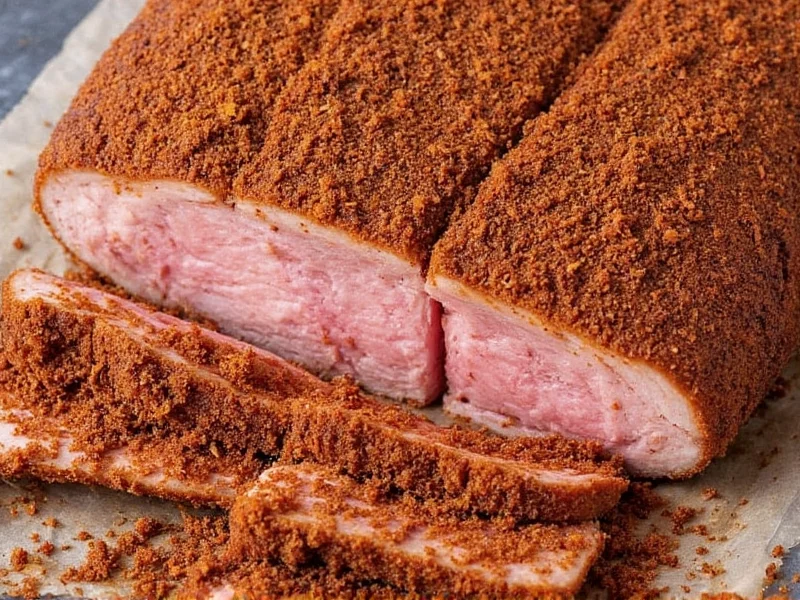Why Pork Butt Needs the Right Rub
Pork butt, also known as Boston butt or pork shoulder, contains abundant marbling that renders during the long cooking process required for pulled pork. The right rub doesn't just add flavor—it creates the essential bark, that flavorful crust which contrasts beautifully with the tender interior. Unlike leaner cuts, pork butt can handle bold seasoning because its fat content balances intense flavors.
Key Factors in Choosing the Best Rub for Pork Butt
Not all rubs work equally well for this specific cut. Consider these critical factors when selecting or creating your perfect pork butt seasoning:
- Salt content—Essential for flavor enhancement and moisture retention
- Sugar balance—Helps with bark formation but can burn if overused
- Spice complexity—Should complement, not overwhelm, the meat's natural flavor
- Application timing—Longer resting periods improve flavor penetration
- Cooking method—Smoking versus slow roasting affects rub performance
Top 5 Proven Rubs for Pork Butt
1. Classic Texas-Style Rub
This simple yet effective blend highlights the meat's natural flavor while creating excellent bark. The best dry rub for smoked pork butt often follows this straightforward approach.
Ingredients:
- ¼ cup coarse kosher salt
- ¼ cup coarse black pepper
- 2 tbsp smoked paprika
- 1 tbsp garlic powder
- 1 tbsp onion powder
Application tip: Apply generously and let rest for at least 12 hours before smoking at 225°F.
2. Coffee-Brown Sugar Rub
Coffee adds earthy depth that complements pork butt's richness without making the meat taste like coffee. This is one of the best coffee rubs for pork butt that delivers complex flavor.
Ingredients:
- 3 tbsp finely ground coffee
- ¼ cup brown sugar
- 3 tbsp paprika
- 2 tbsp kosher salt
- 1 tbsp black pepper
- 1 tsp cayenne (optional)
3. Carolina Mustard Rub
Perfect for those who prefer a tangy profile, this regional favorite works exceptionally well with pork shoulder.
Ingredients:
- ¼ cup yellow mustard powder
- 3 tbsp brown sugar
- 2 tbsp kosher salt
- 1 tbsp garlic powder
- 1 tbsp onion powder
- 1 tbsp smoked paprika
- 1 tsp cumin
4. Simple Salt-Pepper-Sugar Rub
Sometimes less is more. This basic pork butt rub recipe delivers perfect results with minimal ingredients.
Ingredients:
- ¼ cup kosher salt
- ¼ cup coarse black pepper
- 2 tbsp brown sugar
5. Bold Mexican-Inspired Rub
For those who enjoy complex flavors, this blend adds a distinctive twist to traditional pulled pork.
Ingredients:
- 3 tbsp ancho chili powder
- 2 tbsp cumin
- 2 tbsp garlic powder
- 2 tbsp onion powder
- ¼ cup brown sugar
- 2 tbsp kosher salt
- 1 tbsp oregano
| Rub Type | Best For | Salt Ratio | Sugar Ratio | Resting Time |
|---|---|---|---|---|
| Texas Style | Traditional BBQ | 40% | 10% | 12-24 hours |
| Coffee-Brown Sugar | Deep, complex flavor | 25% | 30% | 12 hours |
| Carolina Mustard | Tangy profile | 20% | 25% | 8-12 hours |
| Simple Salt-Pepper | Minimalist approach | 50% | 15% | 24 hours |
| Mexican-Inspired | Bold flavor lovers | 25% | 30% | 8 hours |
How to Apply Rub on Pork Butt for Maximum Flavor
Proper application technique matters as much as the rub recipe itself. Follow these steps for the best results when applying rub to pork butt:
- Dry the surface—Pat the pork butt thoroughly with paper towels to remove excess moisture
- Apply mustard binder (optional)—A thin layer of yellow mustard helps the rub adhere better
- Season generously—Use approximately 1 tablespoon of rub per pound of meat
- Massage into surface—Work the rub into all sides, including crevices
- Refrigerate uncovered—Let the seasoned meat rest for 12-24 hours before cooking
The resting period allows salt to penetrate deeper into the meat through osmosis, enhancing both flavor and texture. This critical step in how long to let rub sit on pork butt transforms good barbecue into exceptional barbecue.
Avoiding Common Rub Mistakes
Even with the best pork shoulder rub recipe, these common errors can ruin your results:
- Using table salt instead of kosher—Table salt is denser and can make your rub overly salty
- Applying too little rub—Pork butt needs generous seasoning due to its size
- Skipping the resting period—Immediate cooking prevents proper flavor development
- Using fresh garlic or onion—These can burn during long cooks; powders work better
- Overloading with sugar—Excessive sugar burns at typical smoking temperatures
How Rubs Interact with the Cooking Process
Understanding the science behind rubs helps you make better decisions. As pork butt cooks slowly at low temperatures (typically 225-250°F), several important processes occur:
- The salt in your rub begins breaking down muscle proteins, improving tenderness
- Sugar caramelizes to form the desirable bark that protects the meat
- Spices bloom in the rendered fat, creating complex flavor compounds
- Smoke particles adhere to the seasoned surface, enhancing overall flavor
For competition-style results, many pitmasters use the "Texas crutch" technique—wrapping the meat in foil or butcher paper after several hours of smoking. If using this method, apply your rub before the initial smoking phase to ensure proper bark formation.
Storing and Preparing Rubs in Advance
Quality dry rubs maintain their potency for months when stored properly. Follow these guidelines for the best results:
- Store in airtight containers away from light and moisture
- Use glass jars rather than plastic to prevent flavor absorption
- Label containers with date and ingredients
- Make small batches (enough for 2-3 cooks) for maximum freshness
- Stir well before each use as ingredients may settle
Pre-mixed rubs often develop more complex flavors after 1-2 weeks as the ingredients meld together. This makes preparing your best dry rub for smoked pork butt ahead of time advantageous.











 浙公网安备
33010002000092号
浙公网安备
33010002000092号 浙B2-20120091-4
浙B2-20120091-4